Stepping Up
A History Of The New Wave Of English Country Dance Music
(Sleeve notes for Topic TSCD 752, 2004).

Tiger Moth ceilidh at Bracknell Festival 1989 (Photo: Jak Kilby)
If some of this looks familiar, it’s because Stepping Up is a greatly expanded version of a vinyl LP first assembled by fRoots magazine in 1988 under the title Tap Roots. This 2004 update neatly celebrates both a new burst of interest in English roots dance music and the 25th anniversary of the magazine that put the original compilation together.
If anybody had thought about country dancing at all back in those now distant, murky days of the 1960s, the term would probably have conjured up half-remembered images of embarrassing junior school sessions prannying about to twee gramophone records or wireless broadcasts of dull bands led by ghastly accordeon players. If anybody had suggested that traditional English folk music had much surviving other than unaccompanied ballads, the idea would largely have been mocked. And of course the general assumption was that all the dance and session tunes were Irish, Scottish or even American – any notion of something distinctively English hardly existed.
But something stirred. A small circle of enthusiasts discovered English village musicians previously unknown outside their communities like Scan Tester in Sussex and Walter Bulwer and Billy Cooper in Norfolk, rummaged through archive recordings made by the BBC and early collectors, even dug out the few commercially issued ‘78s’ of English tunes. Tagged ‘English Country Music’ (country as in ‘rural’, not ‘western’) by its proponents, the robust style became increasingly popular amongst musicians turned off by the uninspiring playing of the dance bands then favoured by the English Folk Dance & Song Society, the often navel-contemplating aspects of the folk club scene of the day, and later-on wanting an alternative to the strongly Celtic content of the repertoires of the early folk/rock bands.
Here was an exciting new repertoire of polkas, jigs, hornpipes, schottisches, step dance tunes and waltzes, and a different instrumentation – melodeons, hammered dulcimers, concertinas, tambourines instead of piano accordeons, pipes, bodhrans. Even the fiddles were played in a different way. The tunes had a special character, a different spin on rhythm and a generally slower speed, which made dancers lift up their feet and step. They also had an attractive, deceptive simplicity that made for quick assimilation, but as one grew more expert these tunes would take on a powerful life of their own.
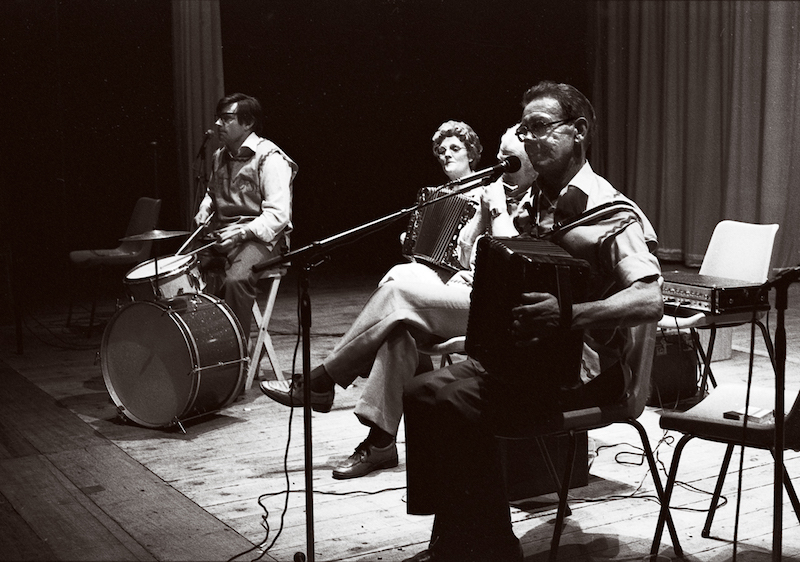
Bob Cann. Photo: Ian Anderson.
Somewhere in the very early ’70s I went into a local folk club and encountered a guest group that quite stopped me in my tracks. Their harmony singing was in familiar folk club style, certainly, but their tunes played on melodeon, concertina, fiddles and tambourine drove along like nothing I’d heard before. Their name was Oak and they consisted of the aforementioned Rod Stradling, his wife Danny, Tony Engle and Peta Webb. Their Topic album, produced by A.L. Lloyd, was to be the first of what would later be tagged ‘The New Wave Of English Country Music’. They were probably the first revival band to play entirely English traditional tunes for English dances, and the seeds of a whole movement were sown.
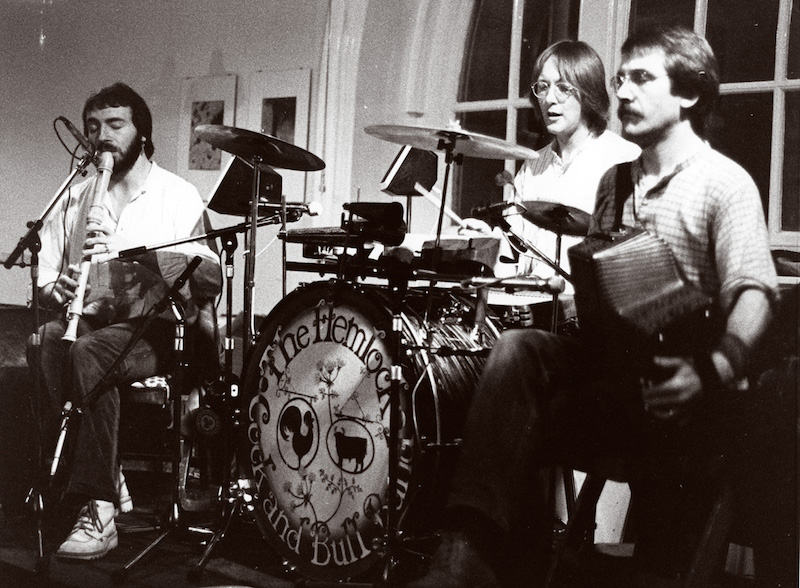
Cock & Bull Band. Photo: Ian Anderson.
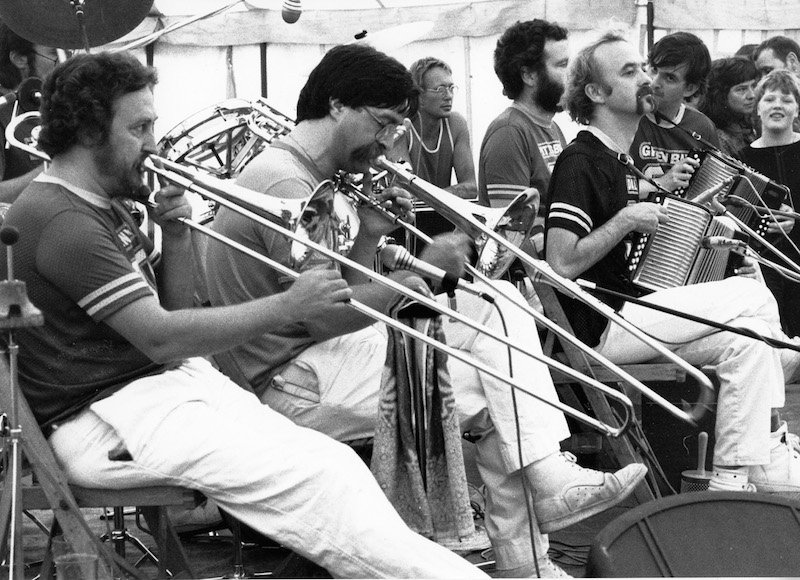
Flowers & Frolics. Photo: Ian Anderson.
In other parts of the country, the idea was slowly catching on too, as witnessed by the track included here from The Leeds Band. By the mid ’70s, through sessions at festivals like Sidmouth and Loughborough, many others were being turned in the same direction. The Free Reed debut albums by The Old Swan Band and London’s Flowers & Frolics (it’s rhyming slang…) resulted in numerous other bands springing up country-wide, often copying the repertoires from the Old Swan and Flowers albums in their entirety. Suddenly, ceilidhs or barn dances – nobody ever came up with a satisfactory new and more English name for them – became all the rage as dancers discovered how the lift given to the music by these melodeon-led bands was so much more exciting than what they’d been used to hearing. There’s a simple technical reason for this – the melodeon has different notes on the push and pull and thus the changes of bellows direction by the players punctuate the rhythm far more than the chromatic piano accordeons.
Further north, one of Jimmy Cooper’s pupils, Chris Coe, her then husband Pete Coe, and three other couples including John Adams and Roger Watson evolved into The New Victory Band who determinedly hunted out a repertoire of tunes from Midland and Northern sources. Also Midlands-based were Umps & Dumps, the outfit which included squeezebox maestro John Kirkpatrick (a regular member of Richard Thompson’s bands of the day) and hammer dulcimer/oboe player Sue Harris.
What must have been the greatest affirmation of the spectacular growth of enthusiasm for English Country Music took place when members of virtually all of these bands plus the surviving traditional players gathered together in Cricklade for the first English Country Music Weekend in July 1977. And everybody, every single band of the day, had a version of Speed The Plough, unearthed from a 78 of The Morris Motors Band which had been arranged by Imogen Holst and recorded for the EFDSS in 1933 by Columbia – many said it was the real English national anthem!
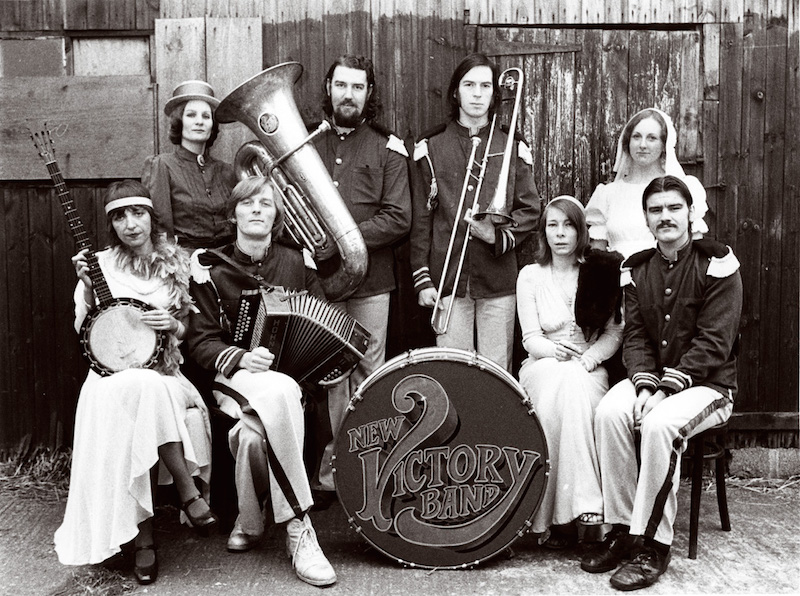
New Victory Band
Others were heading in different directions. The Cock & Bull Band, a Milton Keynes-based outfit, got quite heavily into writing their own original material, unusually including bagpipes in their lineup. For a brief period, the Cock & Bull Band actually became the Albion Band as they were hired en-masse by Ashley Hutchings when his previous set of musicians went off to form The Home Service!
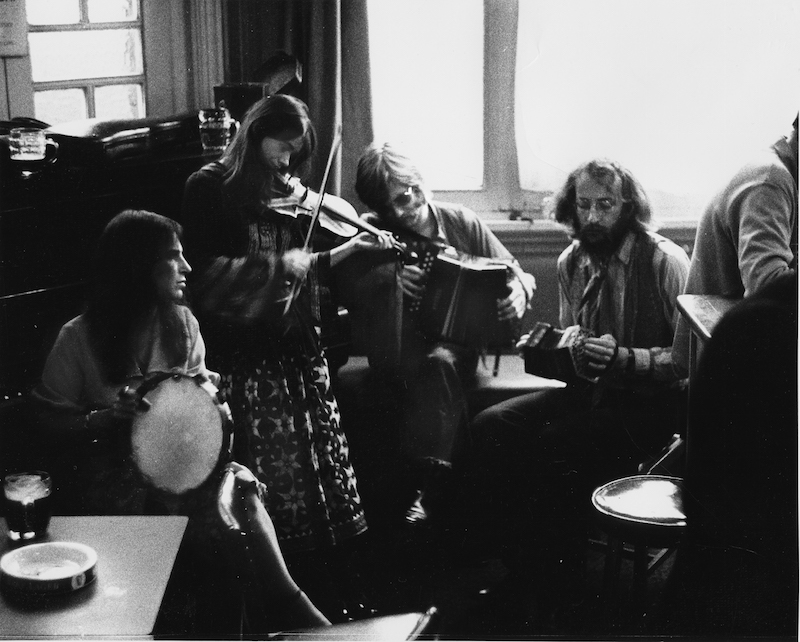
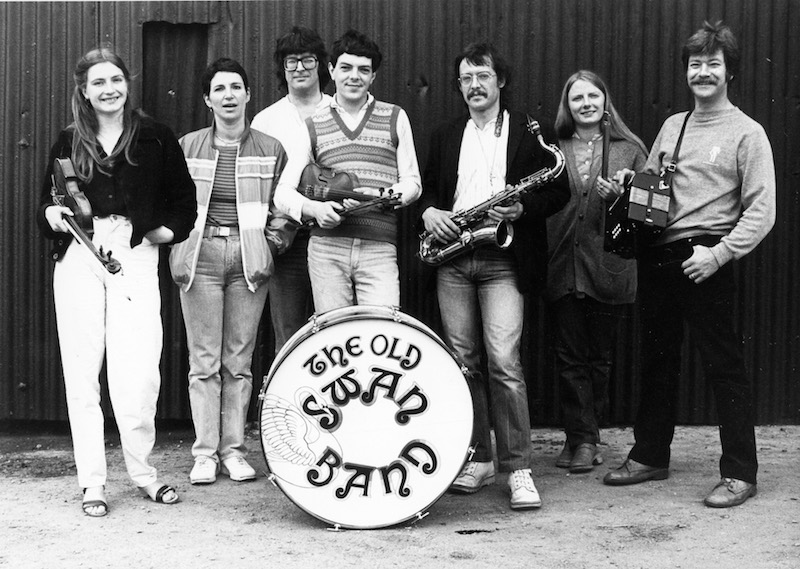
The Old Swan Band. Photo: Ian Anderson.
Rod Stradling, once christened “the guru of English Country Music” by a Melody Maker writer, didn’t rest. Ever pressing forwards, he joined myself, Maggie Holland and Umps & Dumps’ Sue Harris – later replaced by New Victory Band’s Chris Coe – as The English Country Blues Band. John Maxwell from Cock & Bull and Jon Moore from ‘rogue folk’ pioneers Jumpleads were later recruited as we turned into a world-influenced, heavily improvising dance band called Tiger Moth. Not content with playing in just one band, Rod Stradling and Jon Moore also founded Edward II & The Red Hot Polkas, which later evolved into EII and later E2K. Sadly, the Edward II track which was included on the original Tap Roots album wasn’t available for re-licensing this time.

The Oyster Band. Photo: Ian Anderson.
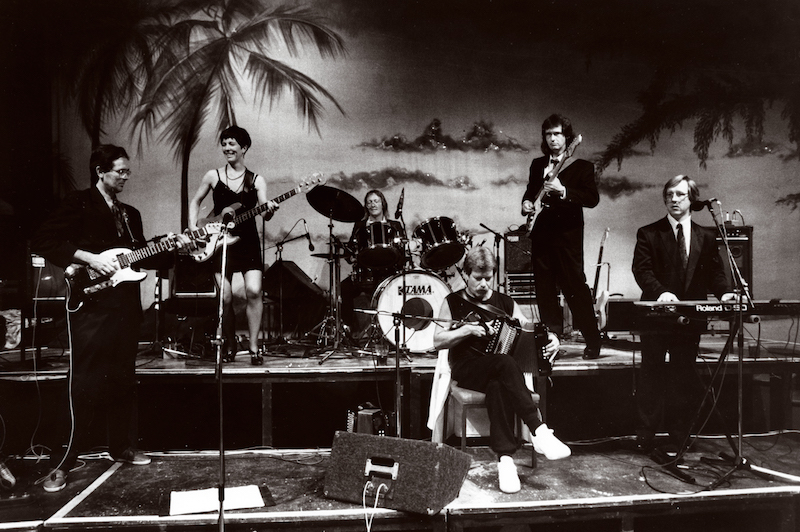
Tiger Moth. Photo: Jak Kilby.
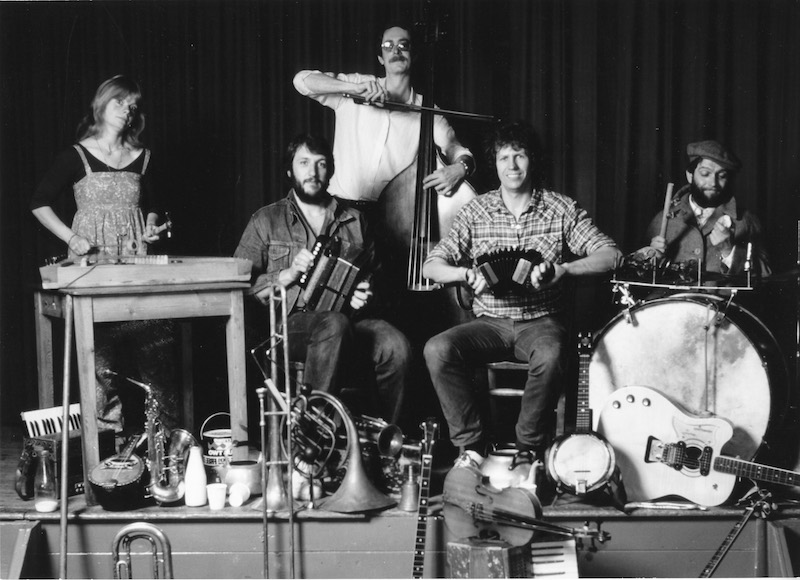
Umps & Dumps. Photo: Bob Naylor.
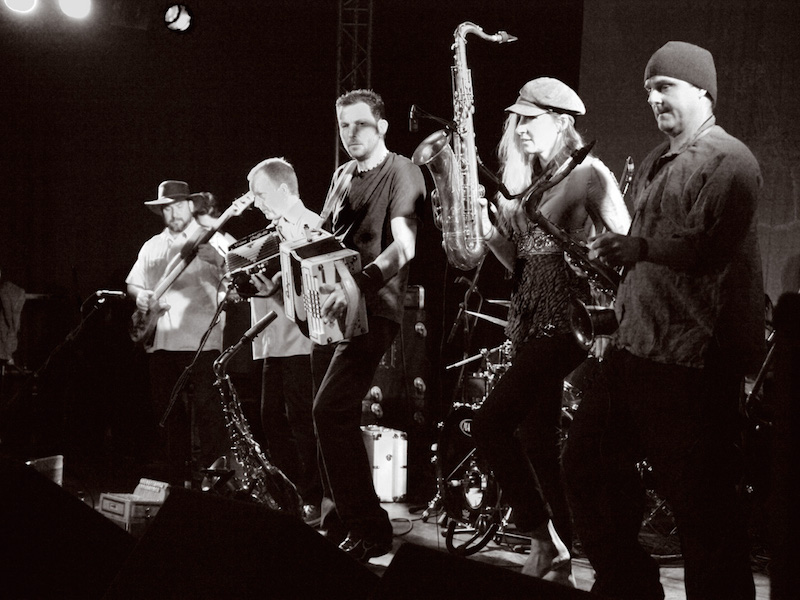
Whapweasel. Photo: Ian Anderson.
Meanwhile, from the other end of the country and definitely state of the art, are Northumberland’s Whapweasel, the nearest thing the current wave has to superstars. They’re pushing onwards from where Oyster Band and Tiger Moth left off, writing all their own tunes, adding a touch of jazz, ska, African music and beyond, and attracting an army of devotees to every dance. But there are legions more young bands out there – the popular Hekety and Bedlam deserve mention, for example – and the whole movement is buzzing and finally evolving again.
If there ever really was something called English Country Music it was always multi-cultural. Go back to that quintessentially traditional 1962 track 2 on this CD: it’s a polka played on instruments including melodeon and hammered dulcimer, none of which started their life in the UK. A fair bit of the repertoire of turn-of-the-last-century country musicians came from mainland Europe, a legacy of the craze for ‘German bands’ in Queen Victoria’s days. When the New Wave Of English Country Music started, the most important thing to do seemed to be to get a grip on the style and so there was initially a craving for some kind of imagined pure ‘authenticity’.
What you have here is functional dance music. It was never meant to be listened to in your armchair (though if you’re like me, you’ll find it hard to remove from your CD player in spite of that!). Given the right breaks, there’s no reason why the enormous, energetic, social fun of English roots dance music shouldn’t break out of the currently thriving festival celidhs and grab the dancing feet of the entire nation.
Ian Anderson, Editor of fRoots
Other Topic releases recommended for further exploration into English traditional dance music: English Country Music (Topic TSCD607); Rig-A-Jig-Jig (Topic TSCD659).
For more reading about the English tradition on the web, explore the Village Music Project and Rod Stradling’s Musical Traditions web site.
Stepping Up was compiled by Ian Anderson. Thanks to the original engineers and producers who include Bill Leader, Nic Kinsey, Jerry Boys, Vic Gamm, John Gill, Mike Warren, Tony Engle, Zuni, Andrew Scott, David Kenny, Barry Coope, Rex Morrey, Martin Appleby, John Howson, Keith Gould, Paul Adams, John Acock, Tim Normanton, Ben Ivitsky, Rick Kemp and Steve Watkins.
Track listing
1. THE MORRIS MOTORS BAND: Speed The Plough Personnel unknown. Recorded 1933, remastered from the Columbia 78. This track is mono.
2. WALTER & DAISY BULWER, BILLY COOPER: Jenny Lind/ The Girl I Left Behind Me Walter Bulwer (fiddle), Daisy Bulwer (piano), Billy Cooper (hammer dulcimer), Reg Hall (melodeon), Mervyn Plunkett (snare drum). Recorded 1962. This track is mono.
3. OAK: New Rigged Ship/ Rig-a-jig-jig Rod Stradling (melodeon), Danny Stradling (tambourine), Peta Webb (fiddle), Tony Engle (fiddle). Topic Records, 1971.
4. THE LEEDS BAND: When There Isn’t A Girl About/Peggy Wood/Looking for A Partner Martin Clarke (melodeon), Don Mackay (melodeon), Jackie Wright (mandolin banjo), Jim Wright (banjo). Topic Records, 1975
5. WEBB’S WONDERS: Herbert Smith’s Polka Tony Engle (anglo concertina), Peta Webb (fiddle), Alan Ward (cello), Ken Lees (banjo). Topic Records, 1975
6. THE OLD SWAN BAND: Walter Bulwer’s Polkas Nos 2 & 1 Rod Stradling (melodeon), Danny Stradling (tambourine, drum), Martin Brinsford (mouth organ, skulls), Fi Fraser (fiddle), Jo Fraser (whistle), Ron Field (autoharp, banjo). Free Reed, 1976.
7. FLOWERS & FROLICS: Down The Road/ See Me Dance The Polka Mike Bettison (melodeon), Roger Digby (concertina), Bob King (banjo), Dan Quinn (melodeon), Ted Stevens (percussion), Alex West (brass bass). Free Reed, 1977.
8. ASHLEY HUTCHINGS: High Level Hornpipe/ Uncle George’s Ashley Hutchings (bass guitar), Bob Cann (melodeon), Jimmy Cooper (hammer dulcimer), Graeme Taylor (electric guitar), Michael Gregory (drums). 1977. From the Kicking Up The Sawdust sessions but not included on the EMI album.
9. THE NEW VICTORY BAND: Harper’s Frolick/ Bonny Kate Pete Coe (melodeon), Chris Coe (hammer dulcimer), John Adams (trombone), Suzie Adams (banjo), Roger Watson (tuba), Helen Watson (keyboards), Ian Wordsworth (percussion). Topic Records, 1978.
10. UMPS AND DUMPS: Marmalade Polka Sue Harris (hammer dulcimer), John Kirkpatrick (concertina), Tufty Swift (melodeon), Derek Pearce (banjo, drums), Alan Harris (bass). Topic Records, 1980.
11. THE ENGLISH COUNTRY BLUES BAND: The Italian Job/ Lodge Road Rod Stradling (melodeon), Chris Coe (hammered dulcimer), Ian Anderson (slide guitar), Maggie Holland (bass guitar, banjo), John Maxwell (drums). Rogue Records, 1983
12. THE OYSTER BAND: Kentish Cricketers/ Galopede John Jones (melodeon), Ian Kearey (bass guitar), Alan Prosser (electric guitar), Chris Taylor (harmonica), Ian Telfer (fiddle, saxophone). Pukka Records, 1984
13. THE COCK AND BULL BAND: One For Dan Dave Whetstone (concertina, guitar), Jean-Pierre Rasle (bagpipes), John Maxwell (drums), Paul Martin (acoustic bass). Topic Records, 1985.
14. GAS MARK 5: Johnny O’Leary’s/Mrs. O’Dwyer’s Trevor Bennett (trombone), Rob Gifford (drums), Nick Havell (trombone), Dan Quinn (melodeon), Chris Taylor (harmonica). Own label, 1987
15. TIGER MOTH: Sloe Benga Rod Stradling (melodeon), Jon Moore (guitar), Ian Anderson (slide guitar), Ian Carter (keyboards), Maggie Holland (bass guitar), John Maxwell (drums), Hijaz Mustapha (guitar). Rogue Records, 1988.
16. THE OLD HAT DANCE BAND: The Flying Pieman/ Ripple Of The Teign/ Gipping Jig Katie Howson (melodeon), John Howson (banjo), Reg Reader (hammered dulcimer), Mel Dean (anglo concertina), Barry Coope (keyboard), Chris Wood (fiddle), Ted Stevens (percussion). Old Hat/ Mellophone, 1992
17. THE GECKOES: The Old John Peel/ Tom Cave’s Dave Parry (melodeon), Andy Turner (anglo concertina), Caroline Ritson (fiddle), John Keston-Hole (guitar), Andy Cheyne (bass guitar), Keith Chandler (percussion). Ock Records, 1995
18. THE POSH BAND: Duke Of Cornwall’s Reel Simon Ritchie (melodeon, percussion), Ed Caines (fiddle), Sue Bainbridge (piano), Ken Lees (banjo). X-Tradition, 1999
19. MARK BAZELEY & JASON RICE: When It’s Night Time In Italy/ Climbing Up The Golden Stairs/ The Thaxted Square Mark Bazeley (accordeon), Jason Rice (melodeon), Rob Murch (banjo), Gareth Kiddier (piano). Veteran, 2000
20. DR. FAUSTUS: May Reel No.1/ Bacca Pipes Jig Tim van Eyken (melodeon), Paul Sartin (fiddle). Robert Harbron (concertina), Benji Kirkpatrick (bouzouki). Fellside Records, 2003
21. GRAND UNION: Queen Of The May/ Watson’s Hornpipe Roger Grimes (melodeon); Taz Tarry (fiddle); Fran Wade (fiddle); Tim Normanson (banjo); Kevin Brown (double bass); Martin Brinsford (percussion, mouth organ). Own label, 2002
22. ELIZACARTHY BAND: No Man’s Jig/ Hanoverian Dance/ Three Jolly Sheepskins Eliza Carthy (fiddle); Jon Boden (fiddle); John Spiers (melodeon); Tim van Eyken (harmonica); Ben Ivitsky (guitar); Tom Salter (electric guitar). Topic Records, 2002
23. WHAPWEASEL: The Final Last Banana/ The Sleeve In The Cheese Robin Jowett (melodeon); Brian Bell (bass guitar); Mike Coleman (cittern); Rob Wilson (drums); Fiona Littlewood (sax); Stuart Finden (sax); Rick Kemp (guitar); Heather Bell (keyboards). Own label, 2003
Shop
You can buy CDs and downloads at our online shop.
Writing
Technology (2002)
Photographers (2002)
English Country Dance Music (2003)
Is That All There Is? (2005)
Self Worth (2007)
Television (2008)
Musical Racism (2008)
Small Venues & the Folkistanis (2009)
Existential Stuff Crisis (2013)
Festival Challenge (2014)